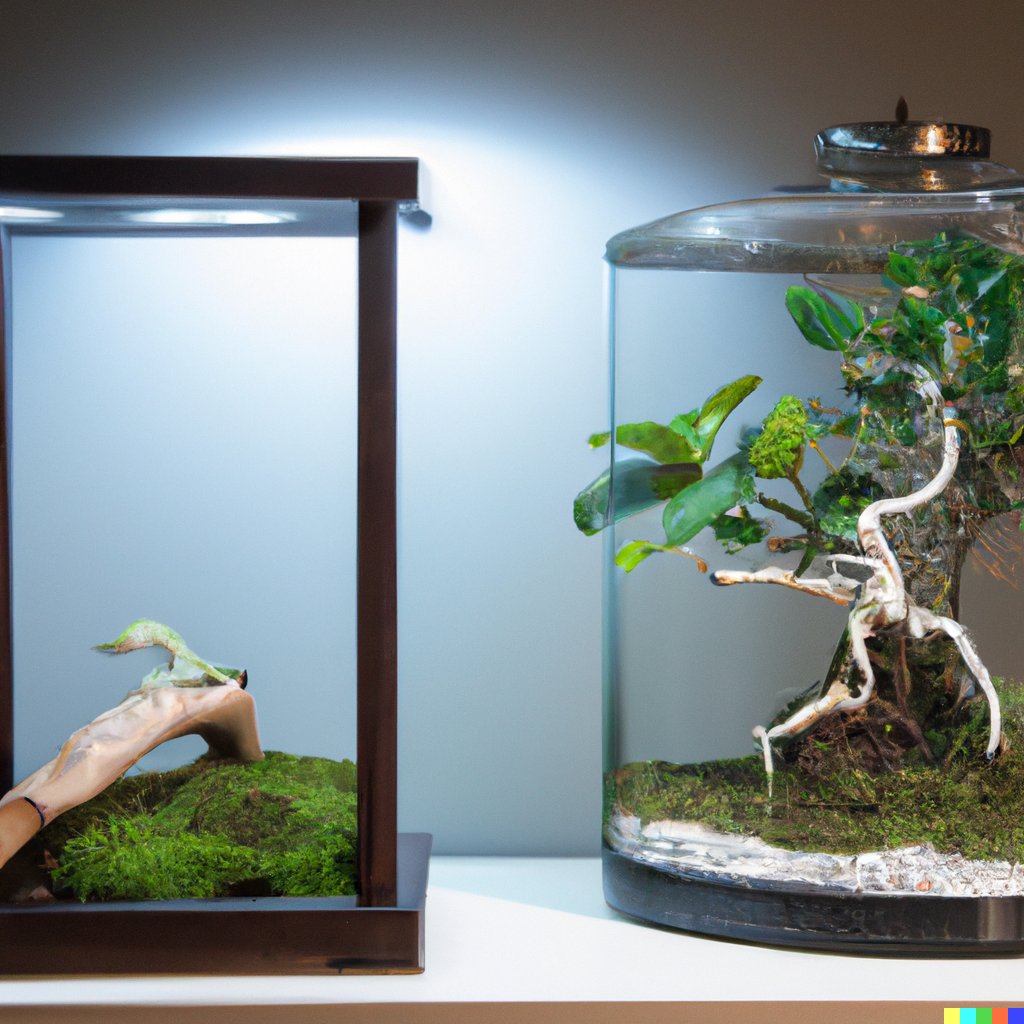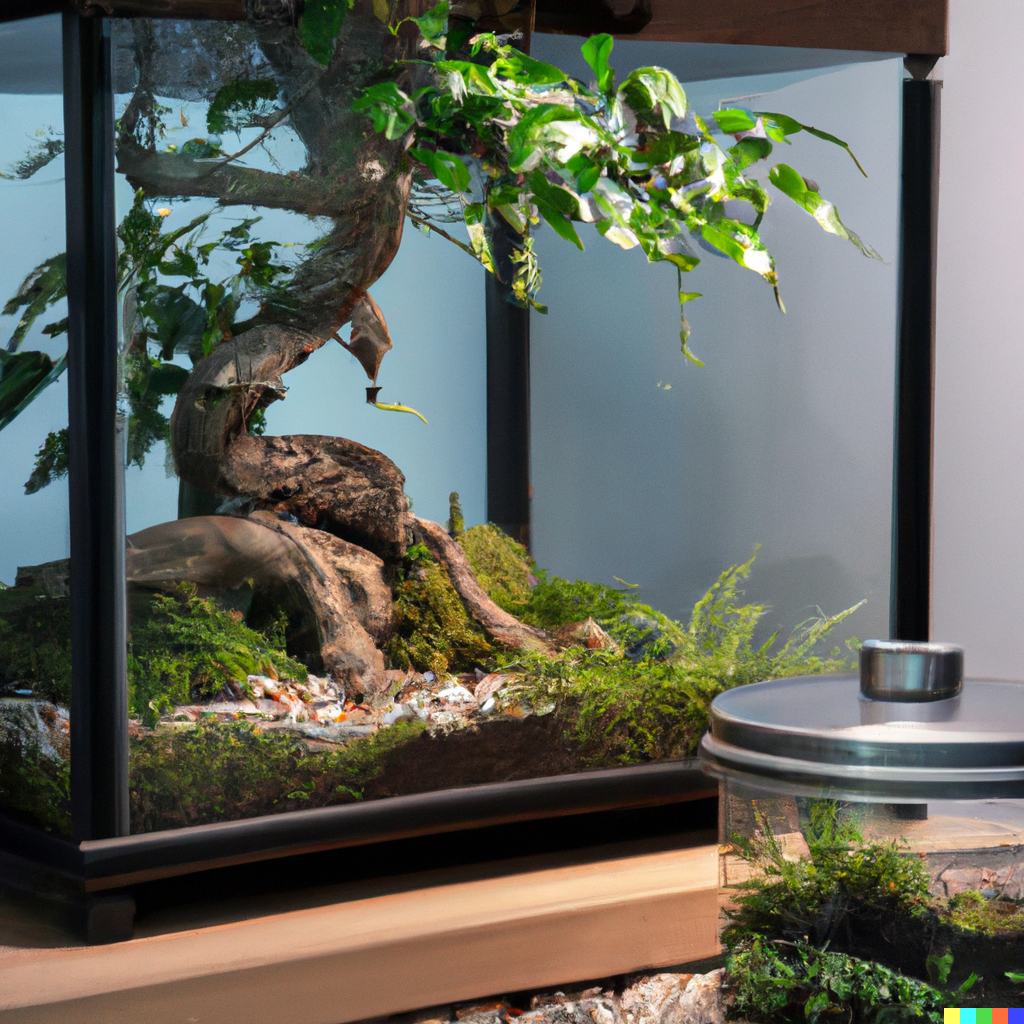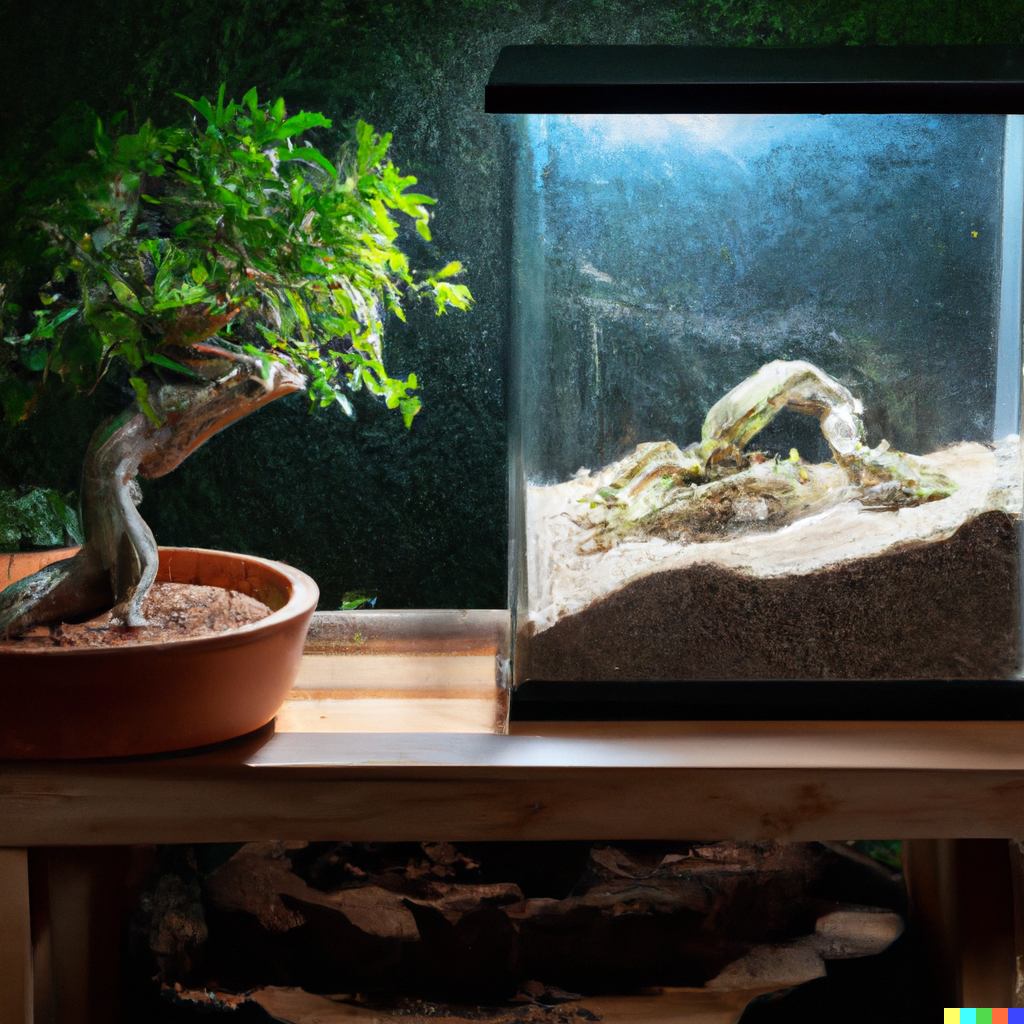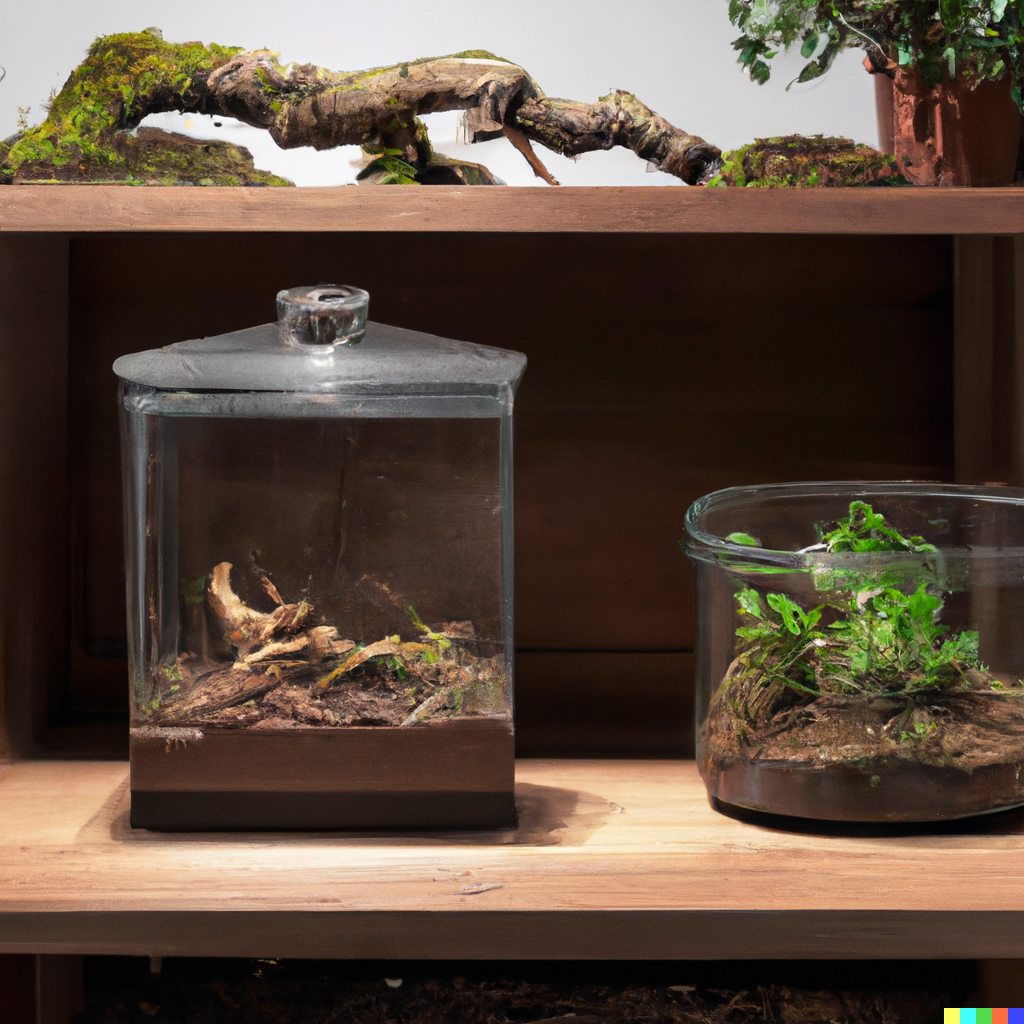Vivarium vs. Terrarium: the allure of replicating nature’s diverse habitats has long fascinated humans. As we’ve advanced in our understanding of ecosystems, we’ve also honed our ability to create miniature versions of these environments. Two such creations, vivariums and terrariums, stand out as popular methods to bring nature closer to us. While they might seem similar, understanding their unique characteristics is crucial for the well-being of the organisms they house. This guide delves into the nuances, highlighting their differences and significance.
Brief Overview of Vivarium and Terrarium
A vivarium is a carefully constructed habitat that seeks to replicate a specific ecosystem or environment in which certain living organisms can thrive. Derived from the Latin word “vivus,” meaning “alive,” vivariums are primarily designed to support life by replicating natural conditions as closely as possible. Typically used for reptiles, amphibians, insects, or specific plant species, vivariums integrate temperature control systems, humidity regulation mechanisms, and often include live plants that mimic the organism’s natural habitat.
In contrast, a terrarium is an enclosed container that simulates a self-sustaining miniature ecosystem. The term “terrarium” originates from the Latin words “terra,” meaning “earth,” and “arium,” referring to a place or container.
This captivating concept allows nature enthusiasts to create microcosms of different landscapes within their homes or offices. Whether it be tropical rainforests teeming with lush foliage or barren desert landscapes dotted with cacti, terrariums offer an opportunity to witness ecological interactions on a small scale.
Comparison Table: Vivarium vs. Terrarium
| Feature | Vivarium | Terrarium |
|---|---|---|
| Purpose | Habitat for specific organisms | Miniature self-sustaining ecosystem |
| Size | Varies; can be large | Typically compact |
| Primary Inhabitants | Reptiles, amphibians, insects, specific plants | Diverse plants, small animals, microorganisms |
| Maintenance | Regular, based on organism’s needs | Minimal, self-regulating |
| Construction | Advanced systems (heating, humidity) | Simple, with focus on balance |
| Aesthetics | Naturalistic, resembling the organism’s habitat | Diverse landscapes, artistic designs |
Key Characteristics of Vivariums:
- Environmental Control: Equipped with temperature and humidity regulation systems to replicate natural conditions.
- Naturalistic Design: Incorporates elements like rocks, branches, and live plants to resemble natural habitats.
- Diverse Inhabitants: Houses a range of organisms, including reptiles, amphibians, and insects.
Key Characteristics of Terrariums:
- Self-Sustaining: Designed to be a balanced ecosystem with minimal intervention.
- Transparent Enclosure: Allows for observation and ensures light penetration for plant growth.
- Thematic Designs: Can be crafted to resemble specific landscapes, such as rainforests or deserts.
Importance of Understanding the Differences
- Optimal Care: Recognizing the unique requirements of vivariums and terrariums ensures the well-being of their inhabitants.
- Setting Expectations: Understanding their distinct purposes helps enthusiasts set realistic goals for each habitat.
- Appreciation of Nature: Acknowledging the intricacies of these enclosures deepens our appreciation for nature’s complexity.

Gaining a comprehensive understanding of vivaria and terraria is vital for several reasons. Recognizing their distinctions allows enthusiasts and caretakers to provide suitable environments for the organisms they wish to house. Different species have unique requirements, including specific temperature ranges, humidity levels, and adaptations to their surrounding ecosystems.
By understanding the differences between vivariums and terrariums, individuals can ensure their creations promote health, well-being, and longevity for the organisms within. Secondly, comprehending the divergent purposes of vivaria and terraria aids in creating realistic expectations for each habitat.
Vivariums focus on providing a suitable living space for particular organisms by replicating natural conditions as closely as possible. On the other hand, terrariums aim to establish self-sustaining miniature ecosystems that require minimal human intervention.
Being aware of these differences helps set realistic goals and allows caretakers to appreciate each habitat’s distinct beauty. Understanding these distinctions fosters a deeper appreciation for the complexity of nature’s wonders.
Both vivaria and terraria endeavor to capture elements of the natural world within artificial confines. By learning about their characteristics and purposes, individuals can better understand how ecosystems function and appreciate the delicate balance required for life’s sustenance.
Vivarium: Exploring the Lush World
Definition and Etymology of “Vivarium”
To embark upon understanding the captivating realm of vivariums, one must first grasp the essence of this term. Derived from the Latin word “vivere,” meaning “to live,” and combined with “-arium,” referencing a place or container, a vivarium is essentially a living space for various organisms.
Originally coined in the context of horticulture to describe enclosed gardens, vivaria have evolved to encompass habitats specifically designed for reptiles, amphibians, insects, and even plants. By creating an environment that mirrors their natural surroundings, vivaria offer inhabitants a thriving oasis that nurtures their existence.
Focus on Creating a Habitat for Living Organisms
At the core of any vivarium lies its primary objective: providing an ideal habitat for its inhabitants. These meticulously constructed enclosures cater to specific organisms’ needs while allowing enthusiasts to observe their fascinating behaviors up close.
Vivaria house an array of creatures, such as geckos slithering through lush foliage or dart frogs gracefully hopping across tropical substrates. This focus on replicating natural ecosystems within confined spaces allows these creatures to thrive while enabling researchers and hobbyists to study their behavior patterns.
Examples: Reptiles, Amphibians, Insects, Plants
Vivaria accommodate a diverse range of organisms from various taxonomic groups. For reptiles like snakes and lizards, these habitats provide an opportunity to simulate their natural environments accurately—be it rainforests or arid deserts—by carefully controlling factors such as temperature, humidity levels, lighting conditions, and substrate composition. Additionally, amphibians like tree frogs or newts find solace within vivaria that mimic their preferred aquatic or semi-aquatic habitats with water features and appropriate humidity.
Insects, too, have their own dedicated vivaria, replete with plants, soil, and microclimates that mirror their wild settings. Furthermore, vivariums designed for plants emphasize the creation of suitable conditions for optimal growth and aesthetics.
Key Characteristics of a Vivarium
A hallmark feature of vivaria is their ability to meticulously regulate environmental conditions necessary for the thriving of its inhabitants. These controlled environments typically encompass temperature and humidity regulation mechanisms like heaters, coolers, misting systems, and foggers. By maintaining an ideal balance within these parameters, vivariums ensure that organisms experience comforts akin to their natural habitats.
Moreover, vivaria incorporate naturalistic setups using substrates such as coco fiber or clay pellets while integrating elements like rocks, branches, caves, or even artificial backgrounds to resemble the dwellings found in the organisms’ native ecosystems. Live plants also play an integral role; they enhance oxygenation and contribute to aesthetic appeal by adding vibrant colors and textures to the living space.
By immersing themselves in the captivating world of vivaria through comprehensive understanding and meticulous design implementation, enthusiasts can create intricate microcosms that mirror nature’s awe-inspiring beauty while ensuring the organisms within thrive harmoniously. (Note: HTML tags have been added for formatting purposes only)
Terrarium: Unlocking the Miniature Ecosystems

Definition and Origin of “Terrarium”
Derived from the Latin word “terra,” meaning earth, a terrarium is a captivating creation that allows nature enthusiasts to bring miniature ecosystems into their homes. Coined in the mid-19th century, the term “terrarium” refers to an enclosed container simulating natural environments and supporting living organisms’ growth and interaction. These captivating glass habitats provide a unique opportunity to observe and appreciate nature’s intricate balance on a smaller scale.
Emphasis on Creating Self-Sustaining Ecosystems in Miniature Form
At the heart of every terrarium lies an unwavering commitment to establishing self-sustaining ecosystems within a confined space. The purpose is to mimic natural environments, such as tropical rainforests, deserts, or woodlands, allowing plants and animals to thrive harmoniously. By carefully selecting compatible species and replicating essential environmental factors like light, temperature, humidity, and soil composition, enthusiasts can unlock the secrets of ecology within these small-scale worlds.
Examples of Terrarium Themes:
- Tropical Rainforest: Recreating the lush green canopies with ferns, orchids, bromeliads, and small arboreal creatures like tree frogs or geckos.
- Desert Oasis: Crafting arid landscapes with succulents, cacti, sand dunes adorned with reptiles like leopard geckos or desert-dwelling insects.
- Woodland Wonderland: Encapsulating serene woodland scenes by incorporating mosses, ferns, small shrubs, and gentle creatures like snails or millipedes.
Key Characteristics of a Terrarium
A successful terrarium centers around specific characteristics that enable its inhabitants to flourish while requiring minimal human intervention.
1. Enclosed Container with Transparent Walls for Optimal Visibility: A terrarium typically consists of a glass or clear plastic container, allowing for a captivating view of the miniature ecosystem from all angles.
This transparency allows observing the delicate interactions between plants, animals, and their environment.
2. Balanced Ecosystem with Living Organisms Interacting Harmoniously: The key to a thriving terrarium is achieving a delicate balance between plants, animals, and microorganisms. Each organism plays its part in sustaining the ecosystem by contributing to nutrient recycling, pollination, decomposition, or pest control.
The intricate web of life intertwines within this confined space.
3. Minimal Human Intervention Required due to Self-Regulation:
Once established and properly maintained, a well-designed terrarium can largely regulate itself. By carefully considering lighting systems, ventilation mechanisms, and moisture levels within the container, enthusiasts can create sustainable habitats that require only occasional intervention for maintenance.
Differences Between Vivariums and Terrariums

Purpose
While both vivariums and terrariums are fascinating enclosures that nurture natural environments within controlled spaces, they serve distinct purposes:
1. Vivariums are designed to provide a suitable habitat for specific organisms. Vivariums focus on creating customized living spaces for particular organisms like reptiles (e.g., snakes or lizards), amphibians (e.g., frogs or salamanders), or insects (e.g., tarantulas or beetles).
These habitats cater to the unique requirements of these creatures by mimicking their natural habitat as closely as possible.
2. Terrariums aim to create![]() self-sustaining miniature ecosystems.
self-sustaining miniature ecosystems.
In contrast, terrariums prioritize recreating entire ecosystems on a smaller scale rather than catering exclusively to specific organisms’ needs. They aim to strike a delicate ecological balance by incorporating various plant species and compatible animals that can interact harmoniously within the enclosed environment.
Size
Size is one noticeable distinction between vivariums and terrariums:
1. Vivariums can vary in size depending on the needs of the organisms. Vivariums come in various sizes, ranging from small enclosures for a single organism to larger structures accommodating multiple species.
The size of a vivarium largely depends on factors such as the organism’s natural habitat, activity level, and space requirements.
2. Terrariums are typically smaller due to their focus on compact ecosystems.
In contrast, terrariums are generally compact in size since their primary objective is to encapsulate entire ecosystems within limited spaces. The smaller dimensions facilitate creating and maintaining the proper environmental conditions necessary for a balanced system to thrive efficiently.
Organism Types
The types of organisms housed in vivariums and terrariums also significantly differ. Vivarium: Primarily suitable for specific organisms like reptiles (snakes, lizards), amphibians (frogs, salamanders), or insects (tarantulas, beetles).
These specialized habitats cater to the unique needs of these creatures by replicating their natural environments as closely as possible. Terrarium: Offers more diversity in terms of organisms; it aims at creating self-sustaining ecosystems that encompass a variety of plants, animals (insects, small reptiles, or amphibians), and microorganisms that interact harmoniously within an enclosed environment.
Conclusion
In this exploration of vivariums vs. terrariums![]() , we have discovered two distinct yet captivating ways to bring nature into our lives. Vivariums allow us to provide specific creatures with tailored habitats while nurturing their well-being.
, we have discovered two distinct yet captivating ways to bring nature into our lives. Vivariums allow us to provide specific creatures with tailored habitats while nurturing their well-being.
On the other hand, terrariums offer an opportunity to unlock intricate miniature ecosystems that thrive with minimal human intervention. By embracing these enclosures, we can gain a deeper appreciation for the delicate balance of nature and find solace in witnessing the wonders of life within our own homes.

